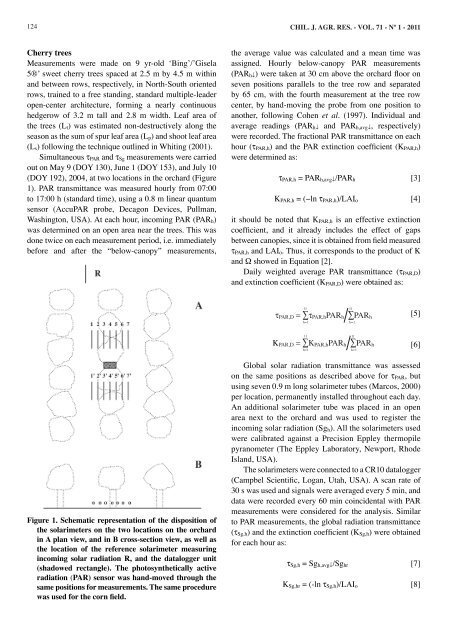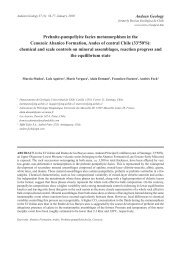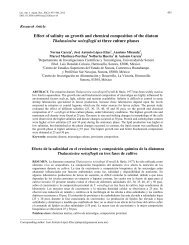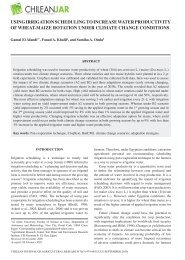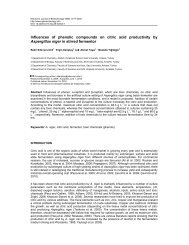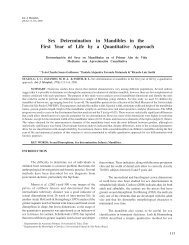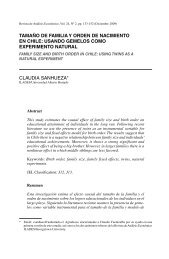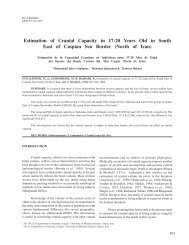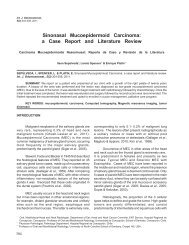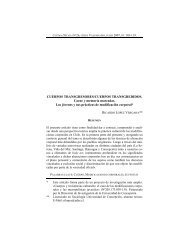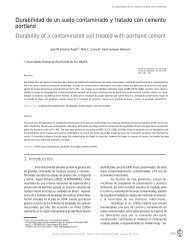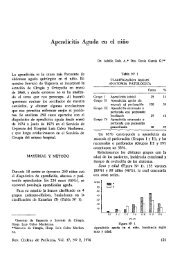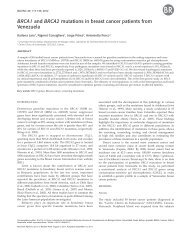(par) and global solar radiation transmittance t
(par) and global solar radiation transmittance t
(par) and global solar radiation transmittance t
Create successful ePaper yourself
Turn your PDF publications into a flip-book with our unique Google optimized e-Paper software.
124 CHIL. J. AGR. RES. - VOL. 71 - Nº 1 - 2011<br />
Cherry trees<br />
Measurements were made on 9 yr-old ‘Bing’/’Gisela<br />
5®’ sweet cherry trees spaced at 2.5 m by 4.5 m within<br />
<strong>and</strong> between rows, respectively, in North-South oriented<br />
rows, trained to a free st<strong>and</strong>ing, st<strong>and</strong>ard multiple-leader<br />
open-center architecture, forming a nearly continuous<br />
hedgerow of 3.2 m tall <strong>and</strong> 2.8 m width. Leaf area of<br />
the trees (L t) was estimated non-destructively along the<br />
season as the sum of spur leaf area (L p) <strong>and</strong> shoot leaf area<br />
(L s) following the technique outlined in Whiting (2001).<br />
Simultaneous τ PAR <strong>and</strong> τ Sg measurements were carried<br />
out on May 9 (DOY 130), June 1 (DOY 153), <strong>and</strong> July 10<br />
(DOY 192), 2004, at two locations in the orchard (Figure<br />
1). PAR <strong>transmittance</strong> was measured hourly from 07:00<br />
to 17:00 h (st<strong>and</strong>ard time), using a 0.8 m linear quantum<br />
sensor (AccuPAR probe, Decagon Devices, Pullman,<br />
Washington, USA). At each hour, incoming PAR (PAR h)<br />
was determined on an open area near the trees. This was<br />
done twice on each measurement period, i.e. immediately<br />
before <strong>and</strong> after the “below-canopy” measurements,<br />
the average value was calculated <strong>and</strong> a mean time was<br />
assigned. Hourly below-canopy PAR measurements<br />
(PAR h↓) were taken at 30 cm above the orchard floor on<br />
seven positions <strong>par</strong>allels to the tree row <strong>and</strong> se<strong>par</strong>ated<br />
by 65 cm, with the fourth measurement at the tree row<br />
center, by h<strong>and</strong>-moving the probe from one position to<br />
another, following Cohen et al. (1997). Individual <strong>and</strong><br />
average readings (PAR h↓ <strong>and</strong> PAR h,avg↓, respectively)<br />
were recorded. The fractional PAR <strong>transmittance</strong> on each<br />
hour (τ PAR,h) <strong>and</strong> the PAR extinction coefficient (K PAR,h)<br />
were determined as:<br />
τ PAR,h = PAR h,avg↓/PAR h [3]<br />
K PAR,h = (−ln τ PAR,h)/LAI o [4]<br />
it should be noted that K PAR,h is an effective extinction<br />
coefficient, <strong>and</strong> it already includes the effect of gaps<br />
between canopies, since it is obtained from field measured<br />
τ PAR,h <strong>and</strong> LAI o. Thus, it corresponds to the product of K<br />
<strong>and</strong> Ω showed in Equation [2].<br />
Daily weighted average PAR <strong>transmittance</strong> (τ PAR,D)<br />
<strong>and</strong> extinction coefficient (K PAR,D) were obtained as:<br />
11<br />
11<br />
τ PAR,D = ∑τ PAR,hPAR h ∑PAR h<br />
h=1<br />
h=1<br />
11<br />
11<br />
K PAR,D = ∑K PAR,hPAR h ∑PAR h<br />
h=1<br />
h=1<br />
[5]<br />
[6]<br />
Figure 1. Schematic representation of the disposition of<br />
the <strong>solar</strong>imeters on the two locations on the orchard<br />
in A plan view, <strong>and</strong> in B cross-section view, as well as<br />
the location of the reference <strong>solar</strong>imeter measuring<br />
incoming <strong>solar</strong> <strong>radiation</strong> R, <strong>and</strong> the datalogger unit<br />
(shadowed rectangle). The photosynthetically active<br />
<strong>radiation</strong> (PAR) sensor was h<strong>and</strong>-moved through the<br />
same positions for measurements. The same procedure<br />
was used for the corn field.<br />
Global <strong>solar</strong> <strong>radiation</strong> <strong>transmittance</strong> was assessed<br />
on the same positions as described above for τ PAR, but<br />
using seven 0.9 m long <strong>solar</strong>imeter tubes (Marcos, 2000)<br />
per location, permanently installed throughout each day.<br />
An additional <strong>solar</strong>imeter tube was placed in an open<br />
area next to the orchard <strong>and</strong> was used to register the<br />
incoming <strong>solar</strong> <strong>radiation</strong> (Sg h). All the <strong>solar</strong>imeters used<br />
were calibrated against a Precision Eppley thermopile<br />
pyranometer (The Eppley Laboratory, Newport, Rhode<br />
Isl<strong>and</strong>, USA).<br />
The <strong>solar</strong>imeters were connected to a CR10 datalogger<br />
(Campbel Scientific, Logan, Utah, USA). A scan rate of<br />
30 s was used <strong>and</strong> signals were averaged every 5 min, <strong>and</strong><br />
data were recorded every 60 min coincidental with PAR<br />
measurements were considered for the analysis. Similar<br />
to PAR measurements, the <strong>global</strong> <strong>radiation</strong> <strong>transmittance</strong><br />
(τ Sg,h) <strong>and</strong> the extinction coefficient (K Sg,h) were obtained<br />
for each hour as:<br />
τ Sg,h = Sg h,avg↓/Sg hr [7]<br />
K Sg,hr = (-ln τ Sg,h)/LAI o [8]


